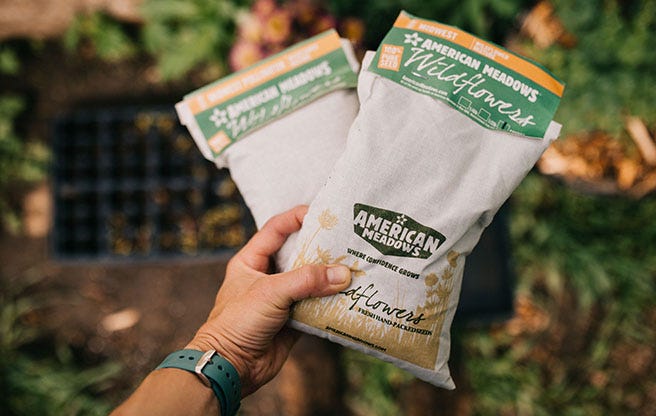Our Pollinator Paradise Flowering Lawn Seed Mix is a lawn alternative that looks great whether you mow it or grow it! Pollinators will love the abundant blooms of Clover and Yarrow. This durable, drought-resistant mix is a great option for home lawns, parks, and slopes, and it is highly adaptable to a variety of soils. Dutch White Clover is widely popular for lawns, where it improves soil health, reduces erosion, and blooms with pollinator-friendly flowers in early summer. It will naturally support lush green grass, without the need for fertilizer. Yarrow (Achillea millefolium) is a vigorous wildflower that can tolerate hot, dry conditions. The two dwarf fine fescue grasses, Marrakech Fescue and Escalante Fescue, feature dense, deep roots for a durable, drought tolerant lawn; they don’t exceed 12 inches in height.
How much seed do I need? See Plant Information below for coverage rates.
When To Plant:
This lawn will germinate in about 10-14 days when the conditions are right; the cool season grasses establish best in spring or fall. The clover and cool season grasses in this mix prefer cooler temperatures for germination and growth, so spring and fall are the best time to plant; avoid planting at the hottest time of year. In spring, you can sow as early as two weeks before your last frost date. In fall, sow 4-6 weeks prior to your first average frost date, so that perennial clover plants have time to establish root systems before freezes hit. In spring you’ll have more weed pressure; planting in fall allows you to avoid the germination time of most weeds.
Soil Preparation:
For the best success with your new planting, we recommend removing existing growth and preparing soil for planting.
Watering:
All new plantings should be kept damp for best results with germination. Water regularly to ensure your soil doesn’t dry out. Once seedlings appear after about 2 weeks, watering can be reduced.
Maintenance:
The benefit of growing clover in your lawn is that it does not need fertilizer! Avoid the use of herbicides. For a natural look, skip mowing altogether, or mow as little as twice a year for a neat look – once in spring and once in fall when grass is most actively growing.
Mow at most once per month, or when grass reaches 5-6 inches tall; do not mow lower than 3.5-4 inches. Do not use fertilizer, as it will cause grass to become taller and leggy. Over time, if thatch builds up to the point where dead grass is visible and the grass begins to thin out, the lawn should be de-thatched in mid-spring before growth begins.
Sowing Seeds:
Using the recommended coverage rate, scatter seeds densely and gently compress seeds for good seed to soil contact. We recommend reserving about 10-15% of seeds so that you can fill patches that may occur.








